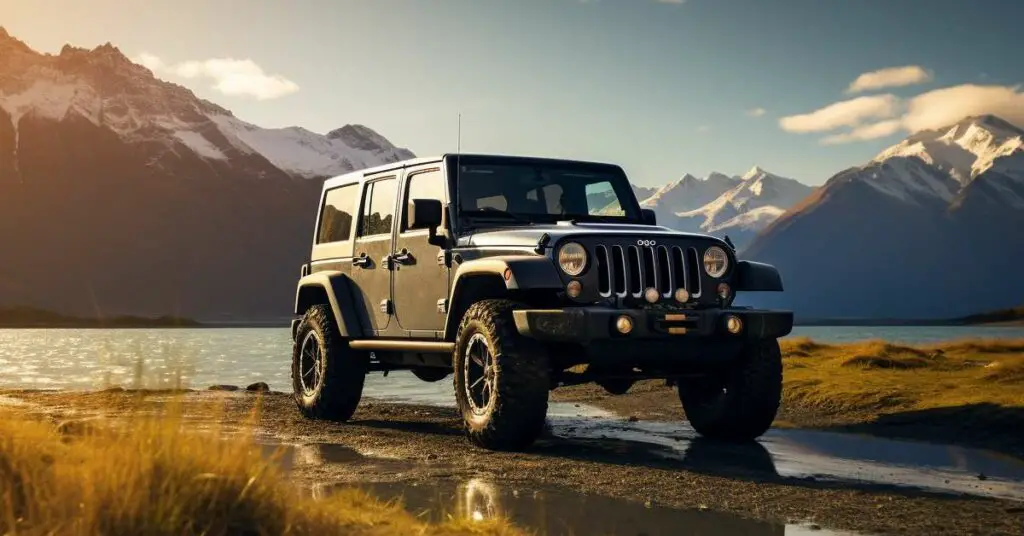
Hey Jeepers, ever felt the urge to go topless but got stuck wrestling with your Wrangler’s hardtop? Don’t sweat it! We’ve got you covered. This guide is your ultimate roadmap to freeing your Jeep from its hardtop shell.
Whether you’re prepping for a summer adventure or you’ve got some essential maintenance to do, knowing how to properly remove your Jeep Wrangler’s hardtop is a skill you’ll cherish. We’ll walk you through every bolt, every lift, and every step you need to confidently strip that top off.
What you’ll get in this guide:
- Why Remove a Hardtop?: Ever questioned if it’s even worth it? We’ll tell you why.
- Types of Hardtops: Know your top before you drop!
- Step-by-Step Process: No more second-guessing.
- Pro Tips & Tricks: Elevate your hardtop removal game.
Why Remove a Hardtop?
So you’ve got a hardtop on your Jeep Wrangler, but why would you want to take it off in the first place? There are several compelling reasons, and understanding them can help you get the most out of your Jeep experience.
Seasonal Changes
Summer’s here, and it’s time to let the sun in. Removing the hardtop is like turning your Jeep into a convertible, perfect for those road trips and beach adventures.
Off-Road Adventures
A lighter Jeep is a more agile Jeep. When you’re tackling challenging terrains, every pound counts. Taking off the hardtop can make your vehicle more maneuverable.
Maintenance and Repairs
Sometimes, it’s not about the fun; it’s about keeping your Jeep in top condition. Removing the hardtop can give you better access for some maintenance tasks or any customization work you’ve got planned.
Resale Value
Believe it or not, demonstrating how to remove the hardtop can be a selling point if you’re planning to sell your Jeep. It shows potential buyers that you know your stuff and have maintained the vehicle well.
By now, you should have a good idea of why taking off that hardtop might be on your to-do list. Whether it’s for the thrill, the practicality, or a mix of both, it’s a skill worth mastering.
Types of Jeep Wrangler Hardtops
Before you grab your toolkit and start unscrewing things, it’s crucial to know what kind of hardtop you’re dealing with. Jeep Wrangler hardtops aren’t a one-size-fits-all deal. They come in various styles, each with its own set of quirks for removal.
One-Piece Hardtops
The classic, the original. One-piece hardtops are a single unit that covers the entire cab area. These are generally the simplest to remove but can be bulky and often require more than one person or a mechanical lift.
Two-Piece Hardtops
These come with a separate front panel, often called the “Freedom Top,” which can be removed independently. This allows for a partial open-air experience without removing the entire hardtop.
Three-Piece Hardtops
A three-piece hardtop offers the most versatility. It usually features two removable panels over the front seats and a larger rear section. You can choose to remove all or just some pieces, depending on your needs.
| Type | Pros | Cons |
|---|---|---|
| One-Piece | Simple removal | Bulky, may need assistance |
| Two-Piece | Partial open-air option | More steps for full removal |
| Three-Piece | Maximum versatility | Most complex removal |
Understanding the type of hardtop you have will guide you through the removal process more efficiently. It will also help you gather the right tools and possibly recruit the right help. After all, knowledge is power, especially when it comes to DIY projects like this.
Pre-Removal Checklist
Alright, you’ve identified your hardtop type. Now, before you dive into the removal process, there’s some groundwork to cover. This checklist ensures you’re fully prepared for a smooth and safe hardtop removal.
Necessary Tools
You don’t want to start the process only to realize you’re missing a crucial tool. Gather everything you’ll need, from Torx wrenches to power drills.
Weather Conditions
Let’s be real; you don’t want to remove your hardtop in a torrential downpour. Check the weather forecast to pick an ideal day for the operation.
Safety Gear
Safety first! Whether it’s mechanic gloves to protect your hands or safety goggles to shield your eyes, don’t skip on the safety gear.
Pre-Removal Checklist:
| Item | Why It’s Needed |
|---|---|
| Torx Wrench Set | For unscrewing fasteners and bolts |
| Power Drill | Speeds up the unscrewing process (optional) |
| Mechanic Gloves | Protects hands from scrapes and provides better grip |
| Safety Goggles | Protects eyes from dust and debris |
| Weather App | To check for rain or other unfavorable conditions |
Step-by-Step Guide to Hardtop Removal
Now that you’re prepared, let’s get down to the nitty-gritty: the step-by-step process of actually removing that hardtop. We’ll break it down into digestible chunks to make it as straightforward as possible.
Step 1: Preparation
Clear your work area of any obstacles that might get in the way. Ensure you have ample space around your Jeep Wrangler to maneuver. Additionally, disconnect any electrical components connected to the hardtop, like a rear wiper or defroster, to avoid damaging them.
Step 2: Unscrewing the Fasteners
Identify the locations and types of fasteners or bolts securing the hardtop. These are usually Torx screws, and you’ll find them at key points around the hardtop’s perimeter. Use your Torx wrench set or power drill to carefully unscrew them.
Step 3: Lifting the Hardtop
Once all the fasteners are out, it’s time for the lift. If you have a one-piece hardtop, you might need assistance or a mechanical lift for this step. For two-piece and three-piece tops, start by removing the smaller sections before tackling the larger rear piece.
Step 4: Storing the Hardtop
You’ve got the hardtop off; great job! Now you need to store it safely to avoid any damage. Use a hardtop storage cart or a designated area in your garage.
Step 5: Reattaching the Hardtop
If you plan to put the hardtop back on later, the reattachment process is essentially the removal process in reverse. Make sure to securely fasten all screws and reconnect any electrical components.
Step-by-Step Breakdown:
| Step | Key Points |
|---|---|
| Preparation | Clear area, disconnect electrical components |
| Unscrewing | Locate and remove Torx screws |
| Lifting | Enlist help or use a mechanical lift |
| Storing | Use a storage cart or designated area |
| Reattaching | Reverse the removal process |
Pro Tips for Hardtop Removal
You’ve got the basics down, but what about leveling up your game? This section is all about those extra nuggets of wisdom that can make your hardtop removal experience go from good to great.
When to Lubricate Screws
If you find that the screws are hard to turn or have some rust, a little lubrication can go a long way. Use a rust penetrant for best results.
Ideal Lifting Techniques
When lifting the hardtop, always use your legs, not your back. If you’re using a mechanical lift, ensure it’s rated for the weight of the hardtop.
Storage Hacks
If you’re short on space, consider wall-mounted storage solutions or even hanging the hardtop from the ceiling of your garage. Just make sure it’s securely fastened to avoid any accidents.
Pro Tips at a Glance:
| Tip | Why It’s Useful |
|---|---|
| Lubricate Screws | Eases the removal process and prevents screw damage |
| Lifting Technique | Ensures you don’t strain your back during the process |
| Storage Hacks | Helps you make the most of limited storage space |
Common Mistakes to Avoid
Even seasoned Jeep owners can make a few missteps when removing their hardtop. In this section, we’ll highlight the pitfalls to watch out for, so your hardtop removal goes off without a hitch.
Stripping Screws
Using excessive force or the wrong tool can strip your screws, making them difficult to remove in the future. Always use the correct size Torx wrench.
Damaging Seals
The rubber seals around the hardtop help keep out rain and noise. Handle them carefully to avoid any tears or deformities.
Ignoring Electrical Connections
Forgetting to disconnect electrical elements like defrosters or wipers can lead to damage. Always disconnect before starting the removal process.
Common Mistakes and How to Avoid Them:
| Mistake | How to Avoid It |
|---|---|
| Stripping Screws | Use the correct Torx wrench and don’t force screws |
| Damaging Seals | Handle seals carefully during removal |
| Ignoring Electricals | Disconnect all electrical elements before starting |
Tools You’ll Need for Hardtop Removal
Let’s talk gear. You wouldn’t go into battle without your armor, right? The same applies here. Having the correct tools on hand can make your hardtop removal a breeze rather than a struggle.
Torx Wrench Set
The bulk of your hardtop is held in place by Torx screws. A complete Torx wrench set is crucial for tackling these.
Power Drill
While not strictly necessary, a power drill with the correct Torx bit can speed up the unscrewing process significantly.
Mechanic Gloves
Protect your hands from scrapes and improve your grip with a good pair of mechanic gloves.
Essential Tools Overview:
| Tool | Purpose |
|---|---|
| Torx Wrench Set | For removing Torx screws |
| Power Drill | To speed up the unscrewing process (optional) |
| Mechanic Gloves | For hand protection and improved grip |
Safety First: Precautions and Best Practices
You can never be too careful, especially when handling something as significant as your Jeep’s hardtop. Safety should always be your top priority. Here are some tips to ensure you’re on the right track.
Proper Lifting Techniques
Always lift using your legs, not your back, to prevent any strain or injury. If the hardtop is too heavy, don’t hesitate to ask for help or use mechanical assistance.
Electrical Safety
Before you begin, make sure to disconnect any electrical components like the rear wiper or defroster. Neglecting this step can lead to electrical issues or even short circuits.
Weather Concerns
We’ve touched on this before, but it’s worth repeating. Always check the weather before you start. You don’t want to be caught mid-removal when a rainstorm hits.
Safety Measures Overview:
| Safety Aspect | Best Practice |
|---|---|
| Lifting Techniques | Use legs, not back, and get help if needed |
| Electrical Safety | Disconnect all electrical components before starting |
| Weather Precautions | Check the forecast; avoid windy or rainy conditions |
Legal Considerations: Warranty and State Laws
Before you get too excited about freeing your Jeep from its hardtop, there are some legal points to consider. Ignoring these could lead to headaches down the line, so let’s dive in.
Warranty Concerns
Check your Jeep’s warranty to see if removing the hardtop yourself might void it. Some warranties require that alterations or removals be done by certified professionals.
State Laws on Hardtop Removal
Believe it or not, some states have laws about driving without a hardtop or with a modified vehicle. Make sure you’re aware of your local laws to avoid any legal troubles.
Legal Considerations at a Glance:
| Legal Aspect | What to Check |
|---|---|
| Warranty | Read fine print; consult dealership if unsure |
| State Laws | Check local laws on hardtop removal or vehicle modification |
Staying within the boundaries of the law is just as important as mastering the technique of hardtop removal. Make sure you’re not only skilled but also savvy about these legal considerations. This way, you can enjoy your open-air Jeep experience without any unwelcome surprises.
Frequently Asked Questions (FAQs)
Questions, questions, questions! Everyone’s got ’em when it comes to removing a hardtop from a Jeep Wrangler. Let’s tackle some of the most common queries head-on.
How Long Does It Take to Remove a Hardtop?
For most people, it takes about 30 to 45 minutes. However, the time can vary based on experience and the type of hardtop you have.
Can I Remove the Hardtop by Myself?
It’s possible but not recommended, especially for one-piece hardtops. Having a helping hand or using a mechanical lift ensures a smoother and safer process.
Do I Need Special Tools for Hardtop Removal?
A Torx wrench set is the primary tool you’ll need. However, a power drill can speed up the process, and mechanic gloves are advisable for added safety.
FAQs at a Glance:
| Question | Quick Answer |
|---|---|
| How long does it take? | 30 to 45 minutes |
| Can I do it alone? | Not recommended |
| Do I need special tools? | Torx wrench set is essential, other tools are optional |
These FAQs cover the basics, but every Jeep Wrangler is a bit unique. Always consult your owner’s manual for model-specific information. The more you know, the smoother the process will go.

As a seasoned mechanic and proud owner of three successful car workshops, I’ve dedicated my life to helping people just like you overcome their everyday automotive challenges. I created this website as a labor of love, with a simple mission: to make car maintenance and repairs more accessible and approachable for the “average joe.”
